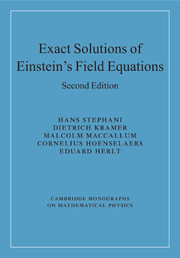Book contents
- Frontmatter
- Contents
- Preface
- List of tables
- Notation
- 1 Introduction
- Part I General methods
- 2 Differential geometry without a metric
- 3 Some topics in Riemannian geometry
- 4 The Petrov classification
- 5 Classification of the Ricci tensor and the energy-momentum tensor
- 6 Vector fields
- 7 The Newman–Penrose and related formalisms
- 8 Continuous groups of transformations; isometry and homothety groups
- 9 Invariants and the characterization of geometries
- 10 Generation techniques
- Part II Solutions with groups of motions
- Part III Algebraically special solutions
- Part IV Special methods
- Part V Tables
- References
- Index
2 - Differential geometry without a metric
from Part I - General methods
Published online by Cambridge University Press: 10 November 2009
- Frontmatter
- Contents
- Preface
- List of tables
- Notation
- 1 Introduction
- Part I General methods
- 2 Differential geometry without a metric
- 3 Some topics in Riemannian geometry
- 4 The Petrov classification
- 5 Classification of the Ricci tensor and the energy-momentum tensor
- 6 Vector fields
- 7 The Newman–Penrose and related formalisms
- 8 Continuous groups of transformations; isometry and homothety groups
- 9 Invariants and the characterization of geometries
- 10 Generation techniques
- Part II Solutions with groups of motions
- Part III Algebraically special solutions
- Part IV Special methods
- Part V Tables
- References
- Index
Summary
Introduction
The concept of a tensor is often based on the law of transformation of the components under coordinate transformations, so that coordinates are explicitly used from the beginning. This calculus provides adequate methods for many situations, but other techniques are sometimes more effective. In the modern literature on exact solutions coordinatefree geometric concepts, such as forms and exterior differentiation, are frequently used: the underlying mathematical structure often becomes more evident when expressed in coordinatefree terms.
Hence this chapter will present a brief survey of some of the basic ideas of differential geometry. Most of these are independent of the introduction of a metric, although, of course, this is of fundamental importance in the space-times of general relativity; the discussion of manifolds with metrics will therefore be deferred until the next chapter. Here we shall introduce vectors, tensors of arbitrary rank, p-forms, exterior differentiation and Lie differentiation, all of which follow naturally from the definition of a differentiable manifold. We then consider an additional structure, a covariant derivative, and its associated curvature; even this does not necessarily involve a metric. The absence of any metric will, however, mean that it will not be possible to convert 1-forms to vectors, or vice versa.
- Type
- Chapter
- Information
- Exact Solutions of Einstein's Field Equations , pp. 9 - 29Publisher: Cambridge University PressPrint publication year: 2003



